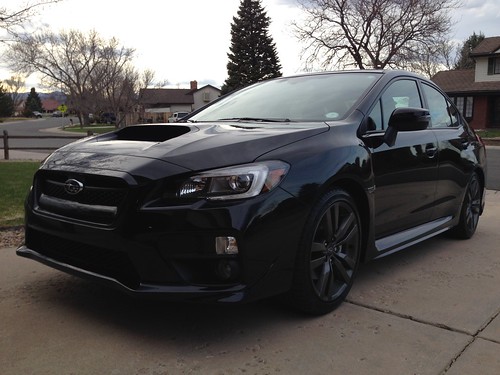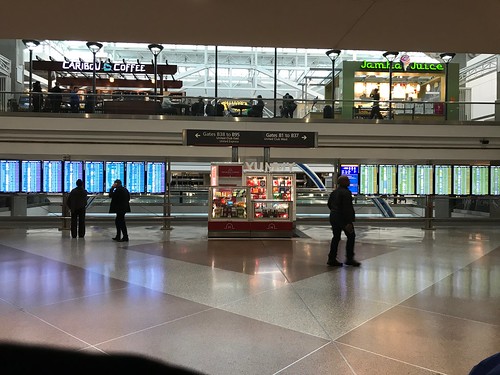
I routinely used the intelligent cruise control on that trip, and it was a marvel: automatically slowing down and then speeding back up as traffic allowed. I did play with the lane keeping on a lightly populated stretch of the Kansas Turnpike. I typically don't use the lane keeping feature in "active" mode, preferring instead to merely have it warn me of a "lane departure". But on the Turnpike, active mode worked as advertised; it was spooky to feel the steering wheel being turned underneath my hands to keep the car in the lane.
Mrs. Overclock and I were on a four lane divided highway in Missouri - maybe US65 - that was not controlled access: it had roads - sometimes gravel - branching off at right angles into the woods on either side of the highway. I had both the collision avoidance and the adaptive cruise control engaged.
I was in the right hand lane when a local in a car right out of the Dukes of Hazzard came roaring past me in the left lane like his hair was on fire. Maybe he suddenly realized his turn was imminent. He cut in front of me and slammed on his brakes to make his turn.
I was paying attention, had my hands on the wheel, and saw all of this. I barely got my foot off the accelerator to apply the brakes when EyeSight simultaneously chopped the throttle, downshifted several times, and slammed on the brakes.
Mrs. Overclock and I were thrown into our seatbelts. My WRX slowed down, the local made his sharp right hand turn onto a gravel road, and we missed rear-ending him. After he turned, EyeSight let off the brakes, accelerated, upshifted, and resumed our prior cruising speed as if nothing had happened.
I'd like to think I could have done as well... but I'm just has glad I didn't have to prove that. It was a remarkable experience.
Never the less, I wouldn't trust EyeSight in my WRX - or Autopilot in your Tesla - to drive the car for me under all foreseeable conditions. EyeSight is good. But not perfect.
In daily driving I've had EyeSight in my WRX, and in Mrs. Overclock's 2016 Subaru Outback station wagon, turn itself off when visibility was very bad due to heavy rain or snow, the lane markings were so worn I couldn't even tell where the lane was, or temporary markings due to construction appeared unclear or ambiguous. Even doing something as mundane as driving through the car wash requires I disable the collision avoidance feature so that the computer doesn't freak out.
Most recently, EyeSight was useless as we crawled home in the Outback from Denver International Airport during the "bomb cyclone" - our flight from Chicago O'Hare (a Boeing 757 in which I am quite sure our pilots kept their hands firmly on the controls) was one of the very few arrivals not cancelled that day - because the ground blizzards reduced visibility to just a few feet beyond the hood of the car. Near the airport, where it was at its worst (it looked like a war zone) we had to resort to using GPS on a mobile phone to determine when we were approaching a major intersection, and what intersection it was, visibility was so poor. (The fact that GPS - possibly augmented by cell tower triangulation - worked at all is a remarkable technical achievement in signal processing.) What we did may have been risky, but it kept us from being among the four thousand passengers that ended up sleeping at DIA that night because the arrival and departure boards were a sea of CANCELLED.

Automation works great... until it doesn't. Driver assist automation is great for augmenting our abilities, but not replacing them.
Automation for self-driving vehicles is a frequent topic of discussion amongst my real-time/embedded colleagues. It may be that it only has to do better than the average human at driving in conditions ranging from ideal to adverse. But our experience driving home from DIA suggests to me that that bar may not actually be all that low.
It's also hard not to ponder the unintended side effects of automation - particularly automation that overrides the human at the controls - when reading about the Boeing 737 MAX 8 story. But that's a topic for another day, when the facts are in.
Update (2022-10-28)
Not that long ago, Mrs. Overclock and I were at a stoplight preparing to exit a parking lot of a furniture store not far from our home. The cross street was a busy multilane state route. Mrs. Overclock was driving her 2016 Subaru Outback station wagon with the Eyesight system.
Our light turned green and she started to pull out. Suddenly the Outback autonomously slammed on the brakes as another car blasted across and through the intersection, inches away from the front of our car, at highway speeds, its driver having clearly missed seeing the stoplight. We could see the eyes of the passengers in the car across from us, which was also pulling out, grow wide.
Subaru's driver assist system may have saved our lives. At the very least, it kept my spousal unit's car from being totaled.

No comments:
Post a Comment